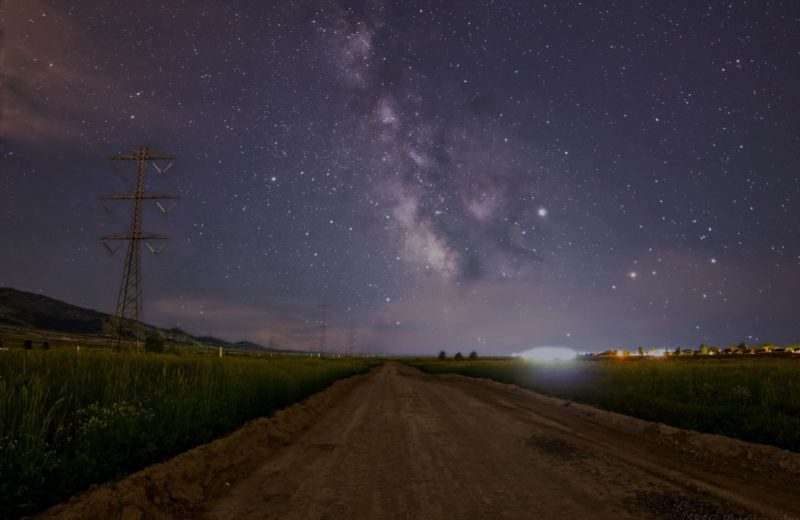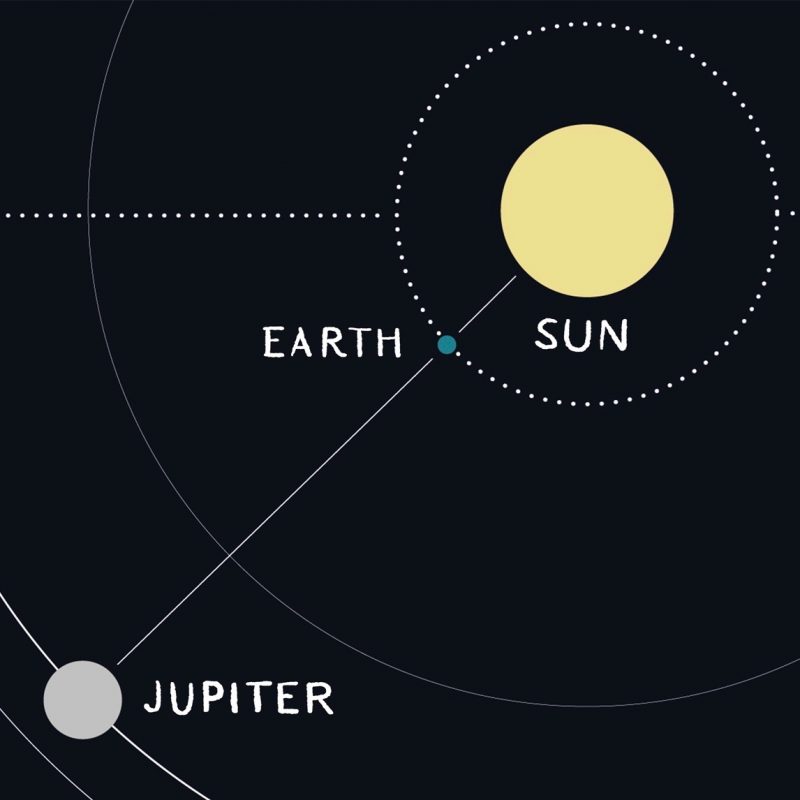
On June 10, 2019, our planet Earth flies between the sun and the outer planet Jupiter. Our faster motion places Jupiter – largest world in our solar system, and an exceedingly bright planet in our sky – opposite the sun about once each year. In other words, Jupiter is now rising in the east as the sun is setting below the western horizon. Astronomers call this event an opposition of Jupiter.
Opposition marks the middle of the best time of year to see a planet. That’s because it’s when the planet is up all night and generally closest for the year (the exact date of Jupiter at its closest this year is June 12).

View at EarthSky Community Photos. | Eli Frisbie created this composite image from photos gathered on June 6, in Eagle Mountain, Utah. He wrote: “The Milky Way shines over a country road with light pollution in the distance. The bright ‘star’ to the right of the Milky Way is the planet Jupiter. The slightly less-bright star to the upper left is the planet Saturn.” Thank you, Eli!
Jupiter is now in the east around sunset. It climbs highest in the sky at midnight (that is, midway between sunset and sunrise). It sets in the west around sunrise.
Jupiter is always bright; it’s the largest planet in our solar system. It shines more brightly than any star in the evening sky. At this 2019 opposition, Jupiter shines in the vicinity of Antares, the brightest star in the constellation Scorpius the Scorpion. There’s no way to mistake Antares for Jupiter, though, because dazzling Jupiter outshines this 1st-magnitude star by nearly 30 times. With the exception of the sun and moon, only Venus – the brightest planet, now low in the east before sunrise – outshines Jupiter.
Try catching both Venus and Jupiter at morning dawn. Venus will be blazing low in the east while Jupiter is sitting low in the west. You’ll need an unobstructed horizon in both directions to see both Venus and Jupiter before sunrise.

When Earth goes between the sun and Jupiter, the giant planet appears opposite the sun in our sky, rising in the east at sunset. Astronomers call this an “opposition” of Jupiter.

Jupiter (red) completes one orbit of the sun (center) for every 11.86 orbits of the Earth (blue). Our orbit is smaller, and we move faster! Animation via Wikimedia Commons.
Technically, as it reaches its 2019 opposition, Jupiter isn’t in front of Scorpius. It’s just north (above) the Scorpion’s northern border. That places Jupiter officially in the constellation Ophiuchus the Serpent Bearer at this 2019 opposition. Jupiter will remain in Ophiuchus until nearly the end of this year. Next year, in 2020, Jupiter will be in front of the constellation Sagittarius the Archer when it comes to opposition.
Ophiuchus isn’t the world’s brightest contellation. Maybe you’ve never taken the time to pick out its stars. If you want to do so, be sure to look in a dark sky. The chart below might help:

Let Jupiter be your guide to the constellation Ophiuchus in 2019. Next year, in 2020, Jupiter will serve as your guide to the constellation Sagittarius. Sky chart via the IAU.
Jupiter comes to opposition about every 13 months. That’s how long Earth takes to travel once around the sun relative to Jupiter. As a result – according to our earthly calendars – Jupiter’s opposition comes about a month later each year.
Last year – in 2018 – Jupiter’s opposition date was May 9.
Next year – in 2020 – it’ll be July 14.
Astronomer Guy Ottewell has a great post at his blog on Jupiter’s oppositions in 2017, 2018 and 2019. Note on the charts below (used with Guy’s permission) that Jupiter at opposition shifts one constellation eastward each year:
April 7, 2017 opposition: Virgo
May 9, 2018 opposition: Libra
June 10, 2019 opposition: Ophiuchus

Jupiter’s path across the sky and opposition dates, 2017-2018, via Guy Ottewell’s blog.

Jupiter’s path across the sky and opposition dates, 2018-2019, via Guy Ottewell’s blog.
Jupiter isn’t a rocky planet like Earth. It’s more like a failed star, not massive enough or hot enough inside to spark thermonuclear fusion reactions, but some 2.5 times more massive than all the other planets in our solar system combined. Jupiter shows us nature magnified!
There’s a NASA spacecraft orbiting Jupiter now. The Juno spacecraft’s orbit carries it low over Jupiter’s poles, providing never-before-seen glimpses of the giant planet’s polar regions. NASA has asked citizen scientists to help process Juno’s images. NASA explained at its JunoCam image processing gallery:
We invite you to download [the raw images], do your own image processing, and we encourage you to upload your creations for us to enjoy and share. The types of image processing we’d love to see range from simply cropping an image to highlighting a particular atmospheric feature, as well as adding your own color enhancements, creating collages and adding advanced color reconstruction.
Here’s a recent image, processed by a citizen scientist:
Happy #CitSciDay2019! This JunoCam image of Jupiter was processed by citizen scientist Kevin Gill. JunoCam's raw images are available for the public to peruse and process into image products at https://t.co/3VG1TGeVA9 pic.twitter.com/ZCYuhEc0h1
— NASA's Juno Mission (@NASAJuno) April 13, 2019
https://platform.twitter.com/widgets.js
Bottom line: Look for Jupiter on the night of June 10, 2019, as this world comes to opposition, the point opposite the sun in our sky. You’d need some 80 Jupiters – rolled into a ball – to be hot enough inside for thermonuclear reactions … for Jupiter to shine as stars do. Yet on this May night – as Jupiter rises opposite the sun – you can imagine it beaming down on us as a tiny sun all night long.
Read more: How to see Jupiter’s moons
Read more: Why is Jupiter closest after we go between it and the sun?
Read more: Is Jupiter’s Great Red Spot disintegrating?
Donate: Your support means the world to us
Source:
https://earthsky.org/tonight/earth-passes-between-jupiter-and-sun